Warsaw
- For other places with the same name, see Warsaw (disambiguation).
Warsaw (Polish: Warszawa) is Poland's capital and largest city, with 1.7 million inhabitants. It is on the Vistula River (Polish: Wisła) in the middle of the country.
Warsaw's history of rapid development after many wars that ravaged and destroyed the city has earned it a reputation as a "phoenix city", able to recreate itself from the ruins and regain its erstwhile glory every time. During the Second World War, it suffered a fate similar to Rotterdam and Dresden in that it was almost completely razed, although in the case of Warsaw it was a much more tragic story of successive destruction and defeat. Due to the great efforts of its surviving inhabitants and, indeed the entire nation, it was rebuilt from a field of rubble, with its historic core recreated, but much of its heritage was lost. Warsaw also had one of the largest Jewish populations in Europe, which for the most part perished during the war, making Warsaw an important place of Holocaust remembrance.
Today, Warsaw is a bustling metropolis and one of the European Union's fastest-developing capitals and the Union's ninth most populous urban centre. It has a mixture of new and old in its eclectic architectural mix, and is constantly changing. While sprawling, it is quite easy to navigate for tourists thanks to a good public transit system, and most important sights are quite close to each other. There is no shortage of accommodation options and a wide choice of restaurants and bars. Warsaw's nightlife is also on the rebound, and a reborn cafe culture has taken over the city. There is a large variety of museums, galleries and other tourist attractions, and there is always something happening throughout the year.
Districts
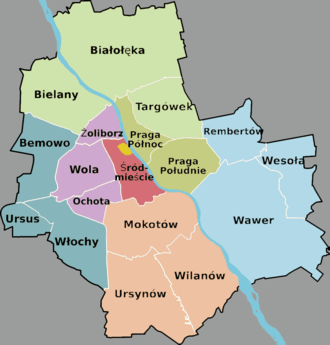
| Old and New Town The Old Town is the historic core of the city that was contained in its erstwhile city walls in the times it was still a small town, before it became the country's capital in the late 16th century. The New Town, directly to its north, was the first expansion of Warsaw beyond those city walls, which compliments the historic core with more buildings from 16th, 17th and 18th century. Both were almost completely destroyed during the Second World War and meticulously reconstructed after the war. |
| Śródmieście The most central district in Warsaw, as implied by its Polish name. It is the area where most travelers will spend their time in Warsaw, as most major attractions and hotels are primarily located here, including the Royal Route with historical royal and noble residences, Jewish monuments and memorials, as well as the modern buildings, including famous Palace of Culture and Science. Administratively, it encompasses both the Old and New Town, described in their separate article. |
| Western Centre (Wola, Ochota, Żoliborz) The districts directly to the west of Śródmieście contain many historic buildings and significant points of interest. Most of the district of Wola has an industrial past, while having been a large part of the Jewish ghetto during the Second World War, it also contains the oldest of Warsaw's cemeteries, but nowadays is changing into a modern high-rise business centre. Żoliborz and Ochota have always had a more residential character, but they are also attractive as a urban complex. |
| Praga (Praga Północ, Praga Południe) The eastern bank of the river was a separate city until the 19th century, and contains its fair share of history and attractions as well. Historically less affluent and considered inattractive or borderline dangerous for decades, it started to develop rapidly into a trendy part of the city in the 21st century. |
| Southern Warsaw (Mokotów, Ursynów, Wilanów) The Southern part of Warsaw is one of the most intensely developing following the Second World War until today. The dense, yet peaceful districts of Mokotów and Ursynów have some interesting gems hidden between the apartment buildings. The southern terminal of the Royal Route, Wilanów is home to the Wilanów Palace. |
| Northern Warsaw (Bielany, Białołęka, Targówek) The northern districts of Warsaw are residential "bedrooms of the city", but with several specific reasons for a traveler to go there. |
| Western Warsaw (Bemowo, Włochy, Ursus) The western parts of Warsaw contains of historical villages mixed with modern estates, are also famous for the Warsaw Chopin Airport. |
| Eastern Warsaw (Rembertów, Wawer, and Wesoła) The sprawling green residential districts remain in contrast with the otherwise dense, highrise apartment complexes of other districts, and have also several specific tourist attractions. |
Understand
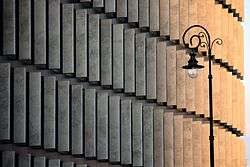
History
Before becoming the capital
There are records of human settlements and economic activity in the area of what is now Warsaw from the 9th century onwards, but it wasn't until the 13th century that Warsaw was founded by the Dukes of Mazovia. While developing as an administrative and economic centre, it played second fiddle to Płock within Mazovia until the 15th century, and was by no means a match for Poland's former capital, Kraków. It gained growing importance due to its economic might and strategically important central location in Poland, cemented when the Polish Sejm (parliament of nobles) relocated there permanently in the 16th century, and it became the site of royal elections.
As capital city of Poland
In 1596, it became the de facto capital of the country when King Sigismund III Vasa decided to permanently relocate to what is now the Royal Castle in Warsaw. The city started to develop rapidly beyond the what is now the Old and New Town, as noblemen started moving in and building mansions and palaces around town. In the 17th century, Praga, on the right-hand side of the river Vistula, was incorporated as a separate town (and did not become a part of Warsaw until the 19th century).
While ravaged by wars and natural disasters as many other European cities in this period, Warsaw continued to grow and modernize, with baroque residences, including Wilanów being built in the 17th century, and the Saxon kings initiating first large-scale urban planning projects in the early 1700s. The last king of independent Poland, Stanisław August Poniatowski, has further modernized the city following the ideals of Enlightenment in the second half of the 18th century.
At the end of 18th century, the weakened Republic of Poland was partitioned, through a period of forced diplomacy, military actions and uprisings, and Warsaw first fell into the Prussian rule, losing most of its importance. As the French emperor Napoleon marched eastwards with his army, he reestablished a small Polish state known as the Duchy of Warsaw, after its eponymous capital, but it was short-lived and was absorbed by the Russian empire in 1815, after Napoleon's defeat.
Under Russian rule
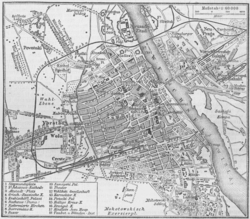
Warsaw remained a capital city under the Russian rule, as the Kingdom of Poland was reestablished, although with Russian tsars as hereditary kings and not much political independence. Warsaw was then the westernmost of major cities of the Russian empire and enjoyed economic growth as a commercial and industrial centre. While repeated uprisings and attempts to regain independence failed, Warsaw was still enriched with the creation of many cultural and educational institutions, many surviving to this day.
Warsaw's growth was curbed by a double line of military forts, protecting the strategically important Russian outpost, which by the second half of the 19th century made Warsaw one of the most dense and overpopulated cities of its time. To aid the failing hygiene, the authorities started constructing the pioneering Warsaw waterworks (led by William Lindley), and first district heating and warm water installations were laid.
At the turn of the century, Warsaw was electrified, gaining its first electric power plant, electric tramways, and a telephone network. At the start of the First World War, Warsaw was bustling, modern city of almost 1 million inhabitants, rife with opulent, belle-epoque architecture adapted to its density.
Between the World Wars
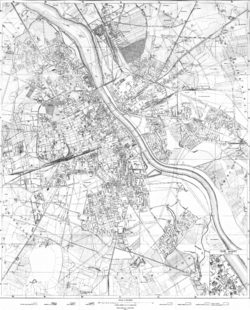
As Poland regained independence, Warsaw became the capital city of an independent country again. It suffered heavily during the war, and was soon threatened by the advancing Soviet forces, who were only repelled at the borders in the 1920 Battle of Warsaw. While political instability and struggles ensued, Poland enjoyed economic growth, optimism and proper attention to planning and urbanism in that period, and Warsaw benefited from that greatly, especially under its last interwar President, Stefan Starzyński.
Warsaw gained a state-of-the-art airport in Okęcie, a central railway through station connecting all major railway links that used to go through or terminate in the city, and an experimental TV broadcasting station. Modern and attractive planned residential districts were created outside of the historic forts line, most notably northwards in Żoliborz and Bielany. Warsaw continued to mix the new and old and many modern buildings filled in gaps between or replaced older buildings across the city, providing for the eclectic look Warsaw for which is known today.
The developments of that time, while later destroyed to a large extent in the Second World War, were instrumental to shaping Warsaw in many ways to how it was known today. Most were either rebuilt verbatim or in a similar form and place, while some survived.
Second World War

For most of the Second World War, Warsaw was occupied by Nazi Germany, but it did not surrender without major fights that affected the city – over 10% of the buildings were destroyed, with the infrastructure and many other buildings damaged. The German authorities treated Warsaw as expendable and had grand plans of totally rebuilding it as a planned city, with Germanic and Nazi symbolism replacing all of the Polish heritage. This did not come into fruition, but explained why little heed was paid to preserving the city, which was also periodically bombed by the Soviet forces after 1941.
It was an especially tragic period for the Jewish population of Warsaw, which had been a significant part of the general population over pretty much all of Warsaw's history. The Nazi forces confined Jews to the Warsaw Ghetto, sprawling over much of the Western Śródmieście and the district of Wola, and proceeded with their plans to annihilate them. In 1942 the Germans carried out the Grossaktion Warschau, when more than 250,000 Jewish people were taken to the death camp in Treblinka. The minority of Jews that stayed in the Ghetto eventually carried out the Warsaw Ghetto Uprising of 1943.
In the final period of the war, the dramatic and tragic Warsaw Uprising took place in 1944. (The Warsaw Ghetto Uprising of 1943 and the Warsaw Uprising of 1944 are entirely separate historic events.) It led to the destruction of most of the remaining buildings in Warsaw and further staggering loss of life, while not achieving its goal of liberating Warsaw from the German forces before the Soviets marched in. The Red Army then captured the crippled and all but razed city, cementing Poland's fate as a communist satellite state of the Soviet Union.
Post-World War II – rebuilding the city
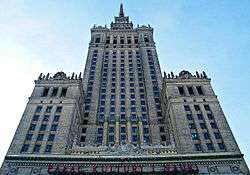
By 1945, Warsaw was almost completely destroyed. It is estimated that over 80% of the city was destroyed, including almost the entire city centre and most historic and significant buildings. Of almost 1.4 million inhabitants, half died during the war (including the vast majority of the Jewish population), others were forcibly removed or escaped voluntarily, and only about 10% of the initial population was found inhabiting the ruins of the city.
To rebuild the city was thus an enormous task, but there was no hesitation in the resolve to achieve it. A special committee of architects and urban planners conducted the efforts. Their paradigms shaped the city as it is known today. On the one hand, there was meticulous effort to restore the oldest and most important historic buildings using extant documentation, but also old photos and even paintings. On the other, the communist ideology ran very much against the character of pre-war Warsaw, and practical reasons and urban planning opportunities dictated planning on a larger scale, envisaging an expansive, much lower-density city.
Most architects and historians held much the late 19th century architecture in low regard and thus many of the historic buildings and areas were rebuilt to resemble their shape in the 18th century or earlier, while ideological and practical reasons limited the restoration of ornamentation to less important buildings, and centralized urban planning provided for a much more harmonious look of the rebuilt historic sections of the city than could be witnessed from before the war. The restoration was mostly completed in the 1940s and early 1950s, but it took until the 1974 to rebuild the Royal Castle. After the Royal Castle, not many other buildings were restored – among notable exceptions are the buildings of the northern side of Plac Teatralny, only recreated in late 1990s.
Apart from historic restoration, in the 1950s Warsaw has also gained a fair share of socialist-realistic architecture, which was all about monumentalism and ideologically-themed decoration. Its most prominent example is the controversial Palace of Culture and Science, which grew to become one of Warsaw's symbols. The emphasis, however, was on housing the returning and rapidly growing population, and thus Warsaw also gained many nondescript, gray residential buildings. As population continued to grow and means were scarce in the centrally-planned socialist economy, the authorities turned to prefabricated concerte, creating sprawling Plattenbau estates around Warsaw.
Contemporary Warsaw
Since the fall of communism in 1989, Warsaw has been developing much more rapidly than Poland as a whole. You wouldn't recognize the city if you saw it ten years ago, and more changes are constantly taking place. Warsaw has long been the easiest place in Poland to find employment, and for this reason many of the Polish inhabitants of the city are first or second generation, originating from all over the country.
|
Capitalist insult The building at Nowy Świat 6/12 served as the headquarters for the Central Committee of the Polish Communist party until 1991 when some creative anti-communists decided to make the communist headquarters the home for the Warsaw Stock Exchange and the Banking Finance Center. The Warsaw Stock Exchange has since moved to the building directly behind the communist HQ, but the irony remains. |
Even though much of Warsaw seems to imitate western cities, there are many peculiarities to be found here that you will not find in western capitals. Examples include the communist-era bar mleczny (lit. 'milk bar') that remain in operation (essentially cheap cafeterias for no-frills, working-class traditional Polish dining, which have remained incredibly popular in the face of westernization). Europe's largest outdoor marketplace, once located around the old stadium, has disappeared as the new National Stadium has arisen for the Euro 2012 football championships.
Climate
| Warsaw | ||||||||||||||||||||||||||||||||||||||||||||||||||||||||||||
|---|---|---|---|---|---|---|---|---|---|---|---|---|---|---|---|---|---|---|---|---|---|---|---|---|---|---|---|---|---|---|---|---|---|---|---|---|---|---|---|---|---|---|---|---|---|---|---|---|---|---|---|---|---|---|---|---|---|---|---|---|
| Climate chart (explanation) | ||||||||||||||||||||||||||||||||||||||||||||||||||||||||||||
| ||||||||||||||||||||||||||||||||||||||||||||||||||||||||||||
| ||||||||||||||||||||||||||||||||||||||||||||||||||||||||||||
Summers in Warsaw can vary from mild to exhaustingly hot. In most residences and some hotels, there is no air conditioning, which means the days and nights can be hot to the point of interrupting one's sleep. Travelers should bring light, summer clothes for the day, but bring an extra jacket for evenings, which can sometimes get a little chilly.
The winters, on the other hand, are brutally cold. Weather can often force the city to come to a standstill. When it snows, it may take up to an hour's time just to travel a few city blocks with traffic at a standstill and road crews seemingly caught off guard (despite warnings from meteorologists in several days in advance). Public transportation will also be utter chaos with buses and trams running late. On the first day of snow in 2010, it took upwards of three hours to travel from Warsaw's Wola district to the northern tip of Warsaw's Mokotów district; a trip that should take no more than 30–45 minutes. Travelers would best be advised to bring heavy, water-resistant shoes with them when traveling in Poland in late Autumn to early Spring.
Tourism
The Warsaw Tourist Office (Stołeczne Biuro Turystyki) is the official tourist information agency in Warsaw and can provide visitors with information regarding attractions, transport and events. They also have free maps and brochures for travelers. They operate four locations in Warsaw:
- in the Palace of Culture and Science, entrance from Emilii Plater Street
- at the Old Town Market Square (Rynek Starego Miasta) in the Old Town
- at the Chopin Airport (until the end of December 2018)
- in the Praga Koneser Centre
The City of Warsaw has a lot of useful information on its website. A popular source of practical tips, contacts, and current event information is the Warsaw Insider, available at every concierge, tourist information centre and larger newsagents. The Warsaw Voice is the city's most popular English-language weekly, and maintains a good calendar of events. Destination Warsaw has some useful information, but you need to be aware that it is run by Warsaw Destination Alliance, whose members are some of the tourist-related businesses in Warsaw, so the website obviously serves their promotional needs. Its main goal is the promotion of Warsaw as a destination abroad.
Orientation
Warsaw and the Vistula
As is the case with most major cities, Warsaw is situated on a river. The Vistula river (Polish: Wisła) crosses the city on a north-south axis, dividing it into two parts. The western part is usually referred to as the left bank (Polish: lewy brzeg adj. lewobrzeżna Warszawa) and the eastern part as the right bank (Polish: prawy brzeg adj. prawobrzeżna Warszawa). Warsaw was founded on the left bank, while the right bank was a separate municipality, called Praga, which was incorporated into Warsaw in the 19th century. Therefore, many would refer to the right bank as "Praga", even if Praga proper is only two districts of the right bank.
Vistula in Warsaw is a broad, sprawling and partly unregulated river, which flooded the surrounding areas often in the past and continues to be somewhat of a threat today. Therefore, Warsaw is not really on the river in the sense many cities like London or Paris are, but rather near to the river, as Vienna is. The historic parts of left-bank Warsaw are a certain distance apart from the river, on an elevation called Warsaw escarpment. The part of left-bank Warsaw closer to the river (and less elevated with regard to it) called Powiśle was, until recently, of rather secondary importance and stature. The right bank is less elevated and most of the development there is separated from the river by a wide belt of shrubbery and natural beaches, allowing for flooding in periods of high tide. It is therefore visually and physically removed from the left bank.
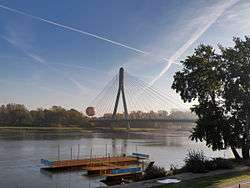
Nine bridges cross the Vistula within the boundaries of Warsaw. They are, starting from south:
- Siekierkowski
- Łazienkowski
- Poniatowskiego
- Średnicowy (railway bridge only)
- Świętokrzyski
- Śląsko-Dąbrowski
- Gdański
- Grota-Roweckiego
- Skłodowskiej-Curie
City centre
Warsaw's left bank, or western part of the city is the dominant part, and the part deemed the city centre lies therein.
The right bank was the first one to become populated, during the 9th or 10th century. However, Warsaw's left bank or the western part of the city is the dominant one, and the present city's central district, called Śródmieście lies on the left bank. The Old Town is fully contained within the borders of the city center.
The central point of the city is located at the intersection of Al. Jerozolimskie and ul. Marszałkowska, near the entrance to the Metro Centrum subway station. The main railway station, Warszawa Centralna, is also close by. It is good to know that the Palace of Culture is a landmark visible from almost any location in Warsaw. Should you ever get lost in the city, just walk toward the Palace of Culture and Science.
Street numbering
Traditionally, streets parallel with Vistula are numbered along the river current, i.e. the buildings with the lowest numbers are the southernmost. Streets roughly perpendicular to the Vistula are numbered from the river upwards, i.e. the lowest numbers are the closest to the river, while streets roughly parallel with Vistula. One side of the street always has even numbers, while the other has odd ones (so if you are looking for number 8 and you see number 7, look at the opposite side of the street). There are several exceptions to those rules, e.g. the Puławska street in southern Warsaw has building numbers starting from the north, while some housing estates have sprawling areas with buildings sharing the same street name, with building numbers assigned in various ways.
City Information System – MSI
The City Information System (MSI – Miejski System Informacji) can be of further aid to visitors to Warsaw. The MSI divides every district into several neighbourhoods (with informative purposes, no administrative or other role), with the neighbourhoods indicated in red on signage throughout the city. You can find the name of the MSI neighbourhood you are in on the red stripes of the building number and street signs. They are also indicated in red on directional signage, showing the way to get to a given neighbourhood. A rundown of the MSI neighbourhoods and helpful schematic maps can be found here: (the website is in Polish, but the schematics are of universal informative value, just click on the district for the rundown of the areas therein)
The districts as such are indicated on signposts with white background, while streets and other POIs with blue background, except for the Old Town and Royal Road areas, where the background is brown and a different font is used to indicate their historic character. The building number signs also often feature a small arrow pointing to the direction the building numbers in a street ascend. Street signs at intersection indicate the building numbers to be found within the block it is in (i.e. until the next intersection). On some signposts you can also find small signs showing the relation of the street they're on to the Vistula.
Other elements that can be of interest to visitors are pylons with neighbourhood maps and transparent boards on historic and significant buildings, which explain briefly their history and significance. Similar boards under street signs explain the origin of the name of the street - in case of streets named after people, they contain a short bio and usually a small portrait. An increasing number of those boards contain descriptions in both Polish and English, while others are in Polish only.
 Street signs at an intersection indicating building numbers to be found in the nearest block
Street signs at an intersection indicating building numbers to be found in the nearest block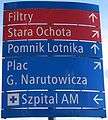 Direction table at a road in Ochota
Direction table at a road in Ochota A pylon with the map of the Royal Road
A pylon with the map of the Royal Road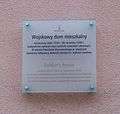 A transparent info board on a historic building
A transparent info board on a historic building A fingerpost in the historic area (Old Town / Royal Road)
A fingerpost in the historic area (Old Town / Royal Road) A small sign indicating the street you are in is perpendicular to the Vistula and you are heading away from the river
A small sign indicating the street you are in is perpendicular to the Vistula and you are heading away from the river
Get in
By plane
Warsaw (all airports code: WRW) has two airports: Chopin Airport (WAW IATA) (also known as 'Okęcie') for major airlines and Modlin Airport (WMI IATA) is only used by Ryanair. The Chopin Airport is within the city limits, some 8 km south of the city centre, while Modlin is in Nowy Dwór Mazowiecki, almost 40 km north of Warsaw city centre.
Łódź Airport (LCJ IATA) is within a 90 minutes drive from Warsaw.
Warsaw Frédéric Chopin Airport
- 🌍 Chopin Airport (WAW IATA). is by far the largest airport in Poland by passenger volumes and number of flights operated or connections. It is located in the area of Okęcie in Włochy, some 8 km south of the city centre. For many years the airport was called just Okęcie, but this reportedly caused confusion and it was renamed. When asking for directions or talking to a taxi driver, always ask for the airport (lotnisko in Polish) to avoid confusion.
Warsaw-Chopin is remarkably close to the city centre among airports serving European capitals, and it also has a very efficient terminal easily handling the 10 million passengers it gets per year. Therefore, you will probably find it easy and quick to use it and can count the time needed from gate to your destination within the city at as little as 45 minutes – even if the airport advises longer and you may want to heed this advice on early mornings and late evenings when the security queues grow longer.
European connections
The Warsaw Chopin Airport has the distinction of being one of the most-connected airports within Europe, with direct connections to every EU capital, as well as many non-EU capitals ranging from Chișinău to Reykjavik (Keflavik Airport), and on top of that to many other cities across the continent. The Chopin airport is also served by almost every major European airline, be it flag carriers or low-fare airlines.
The largest selection of connections is offered by the flag carrier LOT Polish Airlines, a member of Star Alliance, who share the Miles&More frequent flier programme with many other alliance partners. They are mostly geared towards business travellers and tend to be expensive, but you can get a much lower rate if you book in advance a return flight with a stay that includes a weekend (the night from Saturday to Sunday) or at least 3 nights in Warsaw. This also applies to flights with a different origin and return destination, as long as the above rules are kept. LOT faces direct competition from other flag carriers on routes from their bases, and indirect from low-fare carriers. Do check the rates using online comparison tools as you may get a better offer.
LOT has limited its complimentary on-board service on European routes to still water and a small wafer, Prince Polo, which became something of a symbol of Poland abroad (and the minimal on-board service became also an object of widespread ridicule). Coffee and tea, and a range of cold and warm snacks, can be ordered on board at reasonable prices. Coffee and tea are not pre-prepared, and specifically the coffee is provided as instant powder with a cup of hot water (and not brewed during flight).
The major low-fare carriers serving Warsaw Chopin include Wizz Air, who has a base there and flies mostly to secondary airports across Europe (rarely competing with LOT at the same airports), and Norwegian Air Shuttle, who despite the name fly not only from Oslo, but also London and many destinations in Spain. Eurowings has three flights daily to Düsseldorf, and Vueling flies daily to Barcelona.
Intercontinental connections
The intercontinental offerings are mostly limited to North America, with LOT Polish Airlines offering direct flights to New York City, Chicago O Hare, Toronto and Beijing Capital aboard their all-new fleet of Boeing 787 Dreamliners. Two major Gulf carriers, Emirates and Qatar Airways, fly to Warsaw Chopin from their hubs, where you can connect to their intercontinental network. As Warsaw is around 2 hours from most major airports in Europe, you can also easily connect to the intercontinental networks of other carriers.
Terminals
All passenger operations at the Chopin Airport have now been consolidated in one building, called Terminal A, which replaced the previous Terminal 1 and Terminal 2 designations. Please note that Terminal A is now undergoing a major expansion, including a new Renaissance hotel being built on-site, and therefore you can encounter minor disruptions to traffic or be forced to make a detour when getting to or out of the terminal.
To get from the airport to other areas in the city, you have two public transportation options - local trains and buses, as well as taking the taxi.
To/from Chopin Airport by train
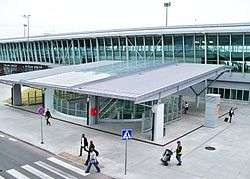
Trains depart every 15 minutes. The Szybka Kolej Miejska (SKM; Warsaw's S-Bahn-like suburban railway system) and Koleje Mazowieckie (Mazovian Railways, the provincial local train operator) operate trains to and from the Chopin Airport.
The SKM offers the following connections from Warszawa Lotnisko Chopina:
- Line S2 through Warszawa Zachodnia, Warszawa Śródmieście (walking distance to Warszawa Centralna), Warszawa Stadion and Warszawa Wschodnia to Sulejówek Miłosna
- Line S3 through Warszawa Zachodnia, Warszawa Centralna and Warszawa Wschodnia to Wieliszew. This is an "express" train which skips the local train stations between Warszawa Zachodnia and Warszawa Wschodnia, including Warszawa Stadion.
Koleje Mazowieckie offers connections between airports (RL line) ending near the Modlin Airport, at the Modlin station (train tickets to Modlin are valid on bus transfer route to Modlin Airport).
Regular Warsaw transport tickets issued by ZTM (the local transport operator which runs city buses, trams and the metro) are valid on SKM train services between the airport and Warsaw. There are ticket machines in the terminal as well as on board. ZTM tickets are also valid on Koleje Mazowieckie trains for journeys inside the city, however if your ticket needs validating, you need to ask the train staff to validate it. Note that while there is no ticket machine on Koleje Mazowieckie trains, it is possible to purchase single tickets aboard the train.
To/from Chopin Airport by bus
Four bus lines operate to and from the airport from 04:40 to 23:00.
- Bus 148 operates between the airport and Rondo Wiatraczna in Praga Południe, on the eastern side of Warsaw. This bus passes by Metro Imielin.
- Bus 175 operates between the airport and Plac Piłsudskiego near the Old Town, crossing through the city center and stopping at the Warszawa Centralna railway station and Metro Centrum, including Nowy Świat and the University of Warsaw. The entire trip takes 30–45 minutes, depending on traffic, and buses depart every twenty minutes. Caution against pickpockets is advised.
- Bus 188 operates between the airport and Gocławek Wschodni in Praga Południe, passing through to the south of the city center, stopping in al. at the Politechnika metro station.
- Bus 331 operates during peak hours only between the airport and the Wilanowska metro station in Mokotów, where many intercity buses stop.
In the night, from 23:00 to 5:00, the night bus N32 runs between the city center (Dworzec Centralny) and the airport.
To/from Chopin Airport by taxi
Avoid the taxi drivers soliciting customers inside the terminal, as they severely overcharge. Instead, use one of the companies recommended by the airport authorities, they have a stand in the arrival's hall. They are slightly above market average in terms of prices and stop near the exit from terminal. You can also order a taxi from another corporation by phone (there is no surcharge), but they can wait for you only in front of the departure terminal. A typical fare to a hotel near Warszawa Centralna station is around 40 zł at night, less in the daytime.
In any case, the most you should pay is 3.00 zł (up to 4.50 zł on Sundays), but typically no more than 2.40 zł per km in the daytime plus an initial fee of no more than 8 zł. You are entitled to a receipt upon request. The Polish word for receipt is rachunek. There is no obligation to tip the taxi drivers, but most won't refuse if you offer. See the Taxis section for a more in-depth explanation of taxi fares.
Warsaw Modlin International Airport
.jpg)
- 🌍 Modlin Airport (WMI IATA). was opened in June 2012. Ryanair is the only carrier that operates from Modlin.
Wizzair and all other carriers, including other low-fare airlines and holiday charter operators, use the Chopin Airport.
Modlin Airport is located in Nowy Dwór Mazowiecki, some 40 km (25 mi) north from Warsaw, and is neither as close nor as conveniently accessible as the Chopin Airport. When choosing your flight, make sure you check which airport will it be operated to/from and factor in the increased time and cost of transportation between Warsaw and Modlin should you choose to use this airport.
Getting to/from Modlin Airport (WMI)
By train
Koleje Mazowieckie operates connections between Modlin and Warszawa Centralna (the RL line). From the airport terminal you need to take shuttle bus to the railway station and get on a train to Warsaw. A combined ticket for bus and train costs 19 zł. The combined travel time may be up to 1½ hours between airport and city centre, including the waiting time at the airport and the railway station.
By bus
Modlinbus resumed direct bus transfers between Warsaw and Modlin Airport on September 30, 2013, with stops at Metro Młociny and Metro Centrum and a schedule matching the Ryanair flights. The bus takes 60 minutes to get from Modlin to Metro Centrum or back, and the regular fare is 35 zł when you purchase the ticket on the bus, and can be much lower when you purchase online in advance.
By train

Warsaw has three stations for long-distance trains:
- Dworzec Centralny or 🌍 Warszawa Centralna (Warsaw Central) (RWA IATA) ul. Emilii Plater
- Dworzec Wschodni or 🌍 Warszawa Wschodnia (Warsaw East) between ul. Kijowska and ul. Lubelska (on the right bank)
- Dworzec Zachodni or 🌍 Warszawa Zachodnia (Warsaw West) Al. Jerozolimskie near Rondo Zesłańców Syberyjskich
Unless you really know what you're doing, the best option is Dworzec Centralny (Warszawa Centralna) station, as it has best connections with all the places in the city. All long-distance trains pass through this station and all stop there. It is the only long-distance station underground. It isn't the last station on the route!
Trains running eastwards start at Warszawa Zachodnia, stop at Warszawa Centralna and then at Warszawa Wschodnia, while trains heading westwards make the same trip in the opposite direction (except that they don't always stop at Warszawa Zachodnia). The same is true for arriving trains. Tourists often find it confusing that the main train station (Warszawa Centralna) is not the last station on the route.
The Berlin-Warszawa Express runs from Berlin to Warsaw daily and is quite inexpensive if booked in advance. Students get discounts as well. It's a fairly comfortable six-hour trip. Schedule are available on Intercity's website and tickets can be booked through Polrail Service or on the Deutsche Bahn website.
One train per day runs to Kaunas and Vilnius in Lithuania, with a change of trains near the border.
There're also trains to Russia – Moscow, Saint Petersburg and even direct cars to Saratov or Irkutsk, Belarus – Minsk, Ukraine – Kiev and direct cars to Simferopol or even Astana in Kazakhstan. There are many direct connections to central and western European cities too.
Most domestic trains, are run by PKP Intercity. Seat reservation is obligatory and free of charge. Trains of all categories, except TLK, are air-conditioned.
Suburban trains
Central station for suburban trains is 🌍 Warszawa Śródmieście (close to Warszawa Centralna and Metro Centrum). Some destinations you can reach from there are Grodzisk Mazowiecki, Łowicz, Milanówek, Mińsk Mazowiecki, Otwock, Piława, Pruszków, Radom, Siedlce, Skierniewice, Sochaczew, Sulejówek, Terespol, Tłuszcz, Wołomin, Żyrardów.
Some suburban trains go through Warszawa Gdańska (Metro Dworzec Gdański) instead of the city centre. From there, you can go to destinations like Ciechanów, Działdowo, Mława and Nasielsk.
Trains going to Wołomin, Małkinia, Tłuszcz and Zielonka depart from Warszawa Wileńska (ul. Targowa near al. Solidarności, also a metro station and a shopping mall there).
Warsaw Commuter Railway
WKD (Polish: Warszawska Kolej Dojazdowa) is separate train service that runs from a distinct platform at Warszawa Śródmieście WKD to Grodzisk Mazowiecki, a city some 30 km west of Warsaw through Pruszków, Milanówek, and Podkowa Leśna.
By bus
Regional and long-distance bus companies in Poland are traditionally called PKS, but most are completely unrelated to the company that once bore that name. In Warsaw, the local PKS is PKS Polonus but PKSes from various other cities also operate. Most PKS buses arrive and depart from either of two major terminals:
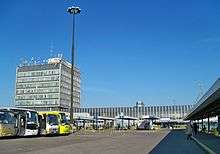
- Dworzec PKS Warszawa Zachodnia, 🌍
Al. Jerozolimskie (near Rondo Zesłańców Syberyjskich). The bigger of the two, next to the railway station by the same name. Most buses arrive here. International buses like Eurolines, Ecolines, Simple Express have their main stop here.
The easiest way to get to the centre is a short train ride from the railway platforms. If you prefer to use the city buses, walk to the other side of Al. Jerozolimskie and take one of those central-bound buses: 127, 158 or 517. During the night, the N35 and N85 buses run to Dw. Centralny every 30 minutes beginning at 23:52. - Dworzec Autobusowy Metro Wilanowska. This station in the south of Warsaw is co-located with a city bus terminus and the Metro Wilanowska metro station. Several bus companies serving towns located south of Warsaw stop here. Flixbus buses from biggest Polish cities, as those from Berlin, Vienna, Bratislava and Prague stop here.
There are also a number of other popular bus terminals and junctions throughout the city, notably:
- 🌍 Metro Młociny. A convenient transport hub at the far north of the city, with a metro station, tram terminus (lines 2, 6, 11 and 33), and a large bus station used by both city lines, suburban buses towards Łomianki and by long-distance bus lines (among others Polski Bus).
- 🌍 Dworzec Centralny. The train station itself is surrounded by bus stops on four sides. One popular stop and drop-off point for smaller buses is located on both sides of Aleje Jerozolimskie. Another, along the Chałubińskiego Str. is used by larger buses (among them Lux Express).
By car
Four European "E-roads" lead to Warsaw: ![]()
![]()
![]()
![]()
![]()
![]()
![]()
![]()
What follows is a list of streets you will find yourself on when approaching the city from different directions:
- North-West: ul. Wybrzeże Gdyńskie or "Wisłostrada" in Bielany and then in Żoliborz (along the left bank):


- North-East: ul. Radzymińska in Targówek and then al. Solidarności in Praga Północ


- East and South East: ul. Płowiecka and ul. Czecha in Praga Południe




- West: ul. Wolska and ul. Połczyńska in Bemowo and then in Wola


- South-West: al. Krakowska in Włochy and then ul. Grójecka in Ochota




The cities listed above are the ones displayed on signs in the city. The abbreviations in (parentheses) show you which neighboring countries can be reached with a road. If you are coming to the city, follow the blue-on-white Centrum signs. One exception is when you are coming from the north-east: follow the Praga sign unless you are driving a lorry.
Driving distances
In Poland – Białystok 190 km (118 mi); Gdańsk 390 km (242 mi); Kielce 180 km (112 mi); Kraków 290 km (180 mi); Olsztyn 210 km (130 mi); Poznań 310 km (193 mi); Siedlce 100 km (62 mi); Toruń 210 km (130 mi)
In other countries – Berlin (D) 570 km (354 mi); Budapest (H) 700 km (435 mi); Kaliningrad (RU) 350 km (217 mi)
.jpg)
Car hire
Most international car rental companies (including Alamo, Avis, Budget, Dollar, Europcar, Hertz, National, Sixt and Thrifty) are present in Warsaw, there are also many local companies. The usual pick-up / return places are the airport, the Warszawa Centralna railway station or major hotels in the city centre, most companies offer to arrange for pick-up and return at other locations at a fee. The regular caveats and requirements as in other European Union countries apply.
It is a legal requirement for you to carry your driving license, insurance documents and the vehicle registration documents at all times when driving the car. If the Police stop you without any of them, they are likely to impose a fine.
Get around
Public transport
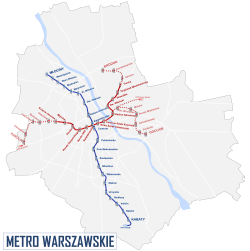
The public transport system in Warsaw is generally well-developed, with some 200 bus routes and 30 tram lines. The route descriptions on the tram stops are easy to follow (although bus stop notices are more complex) but it can last longer, however, to travel between destinations far from the city center. Warsaw has two underground Metro lines, one going from south to north on the left bank, and the other from the east to the west. There are also some regional urban rail services (Polish: Szybka Kolej Miejska or SKM), although they depart at most every 30 minutes only.
All of the abovementioned means of public transit share a single fare and ticketing system, operated by ZTM, a unit within the City of Warsaw responsible for the organization of all public transit.
Metro (subway)
Warsaw's subway system, called Metro, opened in 1995 and is one of the newest underground railway systems in Europe. Operated by Metro Warszawskie sp. z o.o. it runs daily from early morning until midnight at 3-10 minute intervals. On Friday and Saturday, Metro runs until 3AM. Trains and stations are clean and neat. The system consists of two lines; the M1 going from Młociny to Kabaty, and the M2 going from Rondo Daszyńskiego to Dworzec Wileński. The subway does not go to many tourist destinations, however several stations will take you in a general vicinity of some attractions. The M2 is being extended eastwards, another expansion is planned in next few years.
Szybka Kolej Miejska
Szybka Kolej Miejska (SKM) runs on the railway tracks shared with other regional and long-distance trains. SKM trains can be distinguished by their white and ecru livery. SKM reaches many suburban locations outside of the boundaries of Warsaw, as well as the Chopin Airport. SKM stations are quite far from each other, so the trains are best used to traverse longer distances or travel to remote locations within the Warsaw metropolis.
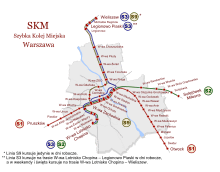
As of 2018, there are four SKM lines, most (S1 and S2) stopping at the Warszawa Śródmieście station in the city centre or the Warszawa Centralna (S3), which is connected to the former by an underground passageway. Except for S9, all of the lines share the same stretch route through central Warsaw between Warszawa Zachodnia and Warszawa Wschodnia, connecting the Śródmieście district to Wola, Ochota and Praga, as well as stopping at Warszawa Stadion station, which serves Stadion Narodowy.
- Line S1 runs between Pruszków and Otwock, through Piastów, Ursus, Włochy, Wawer
- Line S2 runs between the Chopin Airport and Sulejówek Miłosna, through Rembertów and Wesoła.
- Line S3 runs between the Chopin Airport and Wieliszew along the same central rail stretch as long-distance trains, stopping at Warszawa Centralna instead of Warszawa Śródmieście and Warszawa Stadion and in Białołęka
- Line S9 runs between Wieliszew and Legionowo Piaski through Białołęka, Praga, Żoliborz and Wola to Warszawa Zachodnia. It is the only SKM line that will take you to the Warsaw Zoo, but do note that this line does not stop at any station within the core city centre
Buses
Bus route numbers consist of three digits. Only the first digit has any meaning, the latter being merely ordinal. Here's the key to understanding Warsaw bus route numbers:
Normal Expedited Suburban All-Day Service 1xx and 2xx 5xx 7xx Certain Hours Only (Usually Peak) 3xx 4xx 8xx
Other than that:
- Nxx are night routes.
- 9xx are special routes, which operate only a few days in a year.
- E-x are express routes, which link the farthest districts to the city centre, call at very few stops and operate during peak hours only.
- Z-x are replacement routes for trams or metro disabled by maintenance, accident or some other special conditions
Most bus lines operate from around 05:00 to 23:00 (but check the schedule for your particular connection), outside of those hours you need to resort to night buses (see below). The running intervals can be as few as 5 minutes (major routes during peak hours) to nearly 2 hours (certain suburban routes). Usually, you will wait 20 minutes at most.
There are a few routes that are of certain interest to tourists:
- 148, 175 and 188 operate to and from the airport.
- 180, this line drives from Chomiczówka, through Powązki Cemetery, POLIN Museum, The Old Town and Castle Square, by The Royal Route to Łazienki Complex and Wilanów. In many parts 180 is covered by 116.
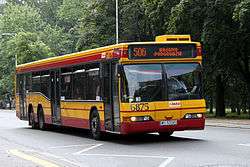
Requesting a stop – certain bus stops are request-only (Polish: na żądanie):
- If you want to get off, press the stop (red) button. In certain older buses, the button is located above the door (and may not be red).
- If you want to get on a bus, wave your hand when you see the bus approaching to indicate your intention to the driver
The doors will not open automatically in air-conditioned buses and trams, and in all of them in the winter. To open it, locate the button labelled drzwi (blue) and press it.
Not all bus stops that have Centrum in their name are in the city center. For example, there is a bus route 525 that goes from Centrum (the actual city center) to Centrum Zdrowia Dziecka in Wawer. This is always clear from the route map.
Night buses
In the night when regular buses, trams, the metro and SKM do not run, a system of night bus lines will take you basically to every part of city. Most buses start and finish at the back of Central Railway Station (Dworzec Centralny). All buses operate at 30-minute intervals and depart from their central stop at Dw. Centralny 15 and 45 minutes after the hour, which facilitates changing. For a map of all the night bus lines visit . Lines operate from different stops within the Dworzec Centralny area – consult the schematic at the bottom of the map to make sure you are waiting at the right stop.
All night bus stops (except for Dw. Centralny and Centrum) are request stops. Signal well in advance to give the bus drivers time to slow down and pull up at the stop.
Trams
Trams in Warsaw have the obvious appeal to tourists in that it is easier to predict where they are going – they usually go straight ahead and only rarely turn, as there are not many tramway junctions in Warsaw. The trams will also have the speed advantage over buses in the city centre during rush hours.
Tram lines have single- and double-digit numbers. Trams with numbers above 40 operate in certain times only. A map of tram routes is available to assist you in planning your journey: . The tram services can end as early as at 22:00, but most routes are served until midnight.
Between June and August, a special tourist line T is operated using historic cars from pl. Narutowicza .
Tickets
Public transportation tickets are issued and controlled by the single Public Transport Authority of Warsaw (Polish: Zarząd Transportu Miejskiego or ZTM) and are valid for all city buses, trams, the metro and SKM. Some tickets are also valid in the suburban trains (Koleje Mazowieckie' and WKD).
Ticket zones
There are only two ticket zones in Warsaw – Zone 1, which covers the entirety of the City of Warsaw within its city limits (including the Warsaw Chopin Airport), and Zone 2, which covers the surrounding municipalities covered by ZTM's common ticketing scheme. It is safe to say that most tourists will never wander outside of Zone 1, unless they have a specific interest in one of the municipalities neighbouring Warsaw. Almost all ticket types exist in two variants – for Zone 1 and for Zones 1+2.
Ticket types and pricing
There are many different ticket options and quirks in Warsaw, but do not get overwhelmed – most of them will not be of interest to a casual tourist. The regular ticket tariff is actually quite simple, with a selection of tickets available. The prices below are for standard tickets in each type; most are also available as reduced price tickets (50%) or for both the 1st and 2nd tariff zones (the latter covering most of Warsaw's far suburbs), usually some 40% more expensive than 1st zone tickets. Note that Poles usually call zone 1+2 tickets just zone 2 tickets.
- Short-term time-limit tickets allow you to travel with unlimited transfers for a limited time. There are three types of those tickets (all prices are for a normal fare, reduced is usually 50%):
- 20-minute (zone 1+2) – 3.40 zł
- 75-minute (zone 1) – 4.40 zł
- 90-minute (zone 1+2) – 7.00 zł
- The 90-minute is your safest bet if you are not sure how far your destination is, or whether it's within the city's limits. For short rides within the city centre usually a 20-minute ticket is more than enough.
- There is also a variety of mid-term tickets allowing you to travel with unlimited transfers for longer periods:
- 24h ticket (zone 1; valid for 24 hours since its validation, not from the moment of sale) – 15 zł
- 24h ticket (zone 1+2) – 26 zł
- 72h ticket (zone 1) – 36 zł
- Weekend ticket (from 19:00 on Friday till 08:00 on Monday) – 24 zł
There are reduced-fare tickets for every ticket type, at 50% of the fare price. There is a long list of those entitled to travel on reduced-fare tickets available at the ZTM website (), but for the most part it does not concern foreign tourists, except for children under the age of 7 and students under the age of 26 in possession of an International Student Identity Card (ISIC).
Senior Citizens: People from 65 to 69 years can get a one-year-ticket for zone 1 and 2 for 50 zł. People from 70 years and older ride for free.
Visit the ZTM website for an overview of available tickets and current ticket prices.
Where to buy?

Tickets can be purchased in automated ticket machines that are abundant across the city, especially at major transit hubs. They are either red and gray or blue and yellow, and rather conspicuous, even if they can be mistaken for an ATM or vice-versa. There are such machines at every metro station and at railway stations within the city centre, as well as at some of the more busy bus stops (e.g. at the Warsaw Chopin Airport). The ticket machines have a multi-lingual menu and are pretty easy to operate if you know what ticket type you want to buy. They accept credit and debit cards, as well as Polish zloty coins and bank notes. Some machines can be quite slow, so take your time and be patient for the machine to respond to your query.
ZTM has a network of service points where you can also purchase tickets. Those are the only places where you can have your personal travelcard made, which you would need if you intend to use a 30- or 90-day ticket.
Many kiosks, shops and post offices also have tickets on sale – it is indicated by a sticker saying Sprzedaż biletów ZTM. Do note, however, that an increasing number of shops and kiosks surrounding the major transit hubs do not sell tickets if there are ticket machines nearby.
In some buses, trams and SKM trains, there are ticket machines which can sell you tickets for the ride on that particular vehicle. They are different from other ticket types in that they have a printed QR code, and that they do not require validation. In case of ticket machine failure, you can purchase your ticket from the train attendant on board the SKM train. In case there is no ticket machine in the vehicle, or it is inoperable, people are not allowed to ride that vehicle and in case of control the fee may be given.
A more convenient alternative to traditional tickets are digital tickets one can obtain through three officially-supported mobile phone apps: SkyCash, MoBilet or mPay.
You can find more information on purchasing tickets and ticket sale locations at the ZTM's English-language website: . A point of sale locator map is also available: .
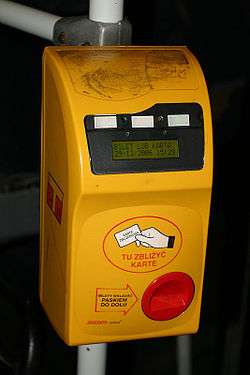
Ticket validation and inspection
Immediately validate your ticket after boarding the bus or tram (in a yellow validator). If one validator is out of order, look for another. A steady yellow light means that only the plastic card reader is working. If all the validators in a bus glow red – they may be locked, likely because an inspection is underway (and it is too late for you) or the driver forgot to turn them on (and you need to remind him or her). If you buy vehicle-and-fare ticket (with the QR code) in special ticket machine inside a bus or tram, you don't need to validate it.
When entering the metro, you will need to validate or present your ticket to open the gate. There are other ways to access the platform for people with special needs (wheelchairs, strollers, large luggage etc.), such as elevators and open gates, so if you are intending on using those, make sure you find a yellow ticket validator before you descend to the platform – they should be next to elevators. Exit gates open without a ticket. Possession of a valid ticket is compulsory for everybody at the metro platform regardless of whether they intend to ride a train or not, even if just using it as an underground passage or accompanying someone.
Timed tickets only need to be activated once, on your first journey. In case of carton tickets, the ticket validator will print the time limit until which the ticket is valid.
Tickets are not checked by the drivers. They may be randomly inspected in a station or in a bus/tram by plain-clothes inspectors with portable ticket/card readers, so it is up to you to have a valid (activated) ticket. The ticket inspectors in Warsaw are paid a commission on the number of fare-dodgers they catch, so they are rarely lenient and generally rather harsh to deal with. Being caught without a valid ticket might be one of the least pleasant experiences possible in Warsaw, so do your best to avoid it.
By car
Parking
There is a paid-parking zone in the center of the city. This applies M-F 08:00—18:00. Parking costs 3.00 zł for the first hour. Subsequent hours cost more although there is no hour limit. 0.60 zł is the minimum payment. You can pay with coins (10 groszy upwards and you will be given the exact time you have paid for after you have paid the minimum charge) or with the Warsaw City Card (not the tourist card). From 2015 the old parking machines have been systematically replaced by the new ones, which no longer accept payment with Warsaw City Card. They do however accept payment with major credit cards. The parking ticket should be left under the windscreen for inspection.
Parking fees can also be paid with mobile phone apps such as moBILET and SkyCash. In that case the driver should leave a special sticker with the name of the app under the windscreen, but a handwritten note is also accepted.
Taxis
The maximum base fare (taryfa 1) is 3.00 zł/km and applies to journeys within the city (zone 1) on weekdays. The cheapest companies charge between 1.40 zł/km and 2.00 zł/km. Taxi drivers can charge 150% of the base fare (taryfa 2) at night or on weekends and public holidays, and 200% of the base fare (taryfa 3) for journeys into the suburbs. Watch out for blue rectangular signs saying taxi 2 strefa (Taxi Zone 2), they can charge 300% of the base fare (taryfa 4) at night and in the suburbs or on weekends and public holidays).
In addition, they can also charge you 8 zł initial fee (closing the door), 40 zł an hour for waiting for you if you you are not in the first zone, and for getting back to the boundary of the first zone if you left in zone 2. There are no surcharges for additional passengers (normally up to 4 should fit), or for luggage.
They cannot charge you for anything else. There is no obligation or custom of tipping the drivers. The driver is required by law to give you a receipt. The full route must be written on the receipt. If the route was suboptimal, the fare can then be challenged. Call the City Guard (Polish: Straż Miejska) at 986 or +48 (22) 986 from a mobile phone should there be any problems.
The aforementioned prices apply only to registered taxis. Others (non-taxi carriers) may charge you whatever they feel like, so they are best avoided.
Uber fares in Warsaw (as of May 2016) are 5 zł for closing the door, plus 0.20 zł per minute, plus 1.40 zł per kilometre.
A legal taxi will have its number displayed on the front door under the window (black digits on white), on a TAXI sign (not TAX1 or TAKI), on a sticker with the base fare displayed on the passenger (rear) door window, and on the driver's ID card visible inside the cab. Note also, that all taxi meter fares are in zł not in euro, even though some drivers will accept payment in euro. In this case he or she will convert the meter fare to euro and most likely round it up to the nearest €5 (to avoid payment with coins, which are harder to exchange). So, if the meter shows "40.0" and you are asked to pay €10 – that's ok, but if the drivers tries to charge you €40, saying that the meter fare is in euro – you are certainly being ripped off.
By bike
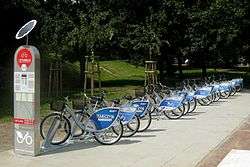
Warsaw is slowly changing into a bike-friendly city, the bike path network covers many parts of the city, but not every important street. You may find yourself forced to ride on the pavement or the street itself at some points, neither of which is really comfortable or advisable – or indeed, can be deemed illegal.
That said, Warsaw started warming up to bicycles, and even has a bike-sharing scheme similar to other cities around the world, called Veturilo. It operates only between March and November (closing for winter). You need a credit card or a bank transfer and a mobile phone to pre-register at the website, and to pay 10 zł initial fee, which is credited to your account. To rent a bike, you need to type in your code and the code of the bike you want to rent at the station, and there you go. The first twenty minutes are free, the first hour is 1 zł and the fees increase every hour, because Veturilo bikes are meant for very short trips. Whenever you completed your trip, just lock your bike in the nearest station and check yourself out. There are maps of nearest points and the surroundings provided at every Veturilo station, the Veturilo mobile app also shows the nearest stations and the list of all available bikes on each station.
See
This is the city of Frederic Chopin, Maria Skłodowska-Curie, Władysław Szpilman and Pola Negri. Warsaw Old Town is inscribed on the UNESCO World Heritage List. Take a walk and explore the streets and squares which have been painstakingly rebuilt after last war. Check out tumultuous history of the metropolis located on the both sides of Vistula river. Explore special places and associated with the uprisings, especially one, which took place in the Ghetto and second, which happened in 1944. Book guided city walk across the city and discover how it has changed since the fall of communism. Most of the major sightseeing attractions are concentrated in Śródmieście, with some more in surrounding districts, the exception park and palace in Wilanów. Check the attractions of the Vistula river banks. That said, every district has something to offer if you have the time and want to research more, so do refer to district articles for details.
That said, most tourists will probably:
- Visit the Old and New Town, the (recreated) oldest part of the city of Warsaw with the Royal Castle
- From there, stroll down Krakowskie Przedmieście and Nowy Świat streets (the "Royal Route")
- See Łazienki Park with the Chopin Monument (and attend one of the free open-air concerts in the summertime)
- Take the elevator to the top of Palace of Culture and Science for a panoramic view of the city, or at least take a photo of this modern-day symbol of Warsaw
- Visit the most important museums – Warsaw Uprising Museum, National Museum and the POLIN Museum of the History of Polish Jews.
Itineraries
- The Royal Route (Trakt Królewski) began as a track linking the Royal Castle to the Royal Palace in Wilanów (Pałac Królewski w Wilanowie), some 10 km farther. There are many points of interest along the route, and there's a Poster Museum (Muzeum Plakatu) in Wilanów.
- The Vistula Boulevards (Bulwary Wiślane)
Do
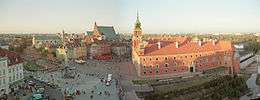
Explore
Go on a Tour of Warsaw – the Old Town and surrounding districts are sufficiently compact to allow a number of excellent walking tours through its history-filled streets. You'll see amazing things you would otherwise miss. Details are usually available from the reception desks of hostels and hotels.
Concerts and performances
Warsaw is home to several professional musical and play companies. Being the capital city means the Polish National Opera and the Warsaw Philharmonic (also, National Philharmonic) call Warsaw home. There are a number of other companies, including play companies and theaters that will likely be of interest to travellers.
Festivals
- The Cross-Culture Warsaw Festival (Festiwal Skrzyżowanie Kultur). World music festival. Concerts and music workshops, documentary screenings, exhibitions.
- Jewish Culture Festival – The Singer's Warsaw (Festiwal Kultury Żydowskiej – Warszawa Singera), e-mail: festiwalsingera@shalom.org.pl. August.
- Warsaw Film Festival (Warszawski Festiwal Filmowy). October.
- Planete+ Doc Film Festival. Documentary films. May.
- Burn Selector Festival. Electronic & alternative music festival. September. 250 zł for two-day pass.
- Orange Warsaw Festival. Big pop music festival on the Horse Racetrack Służewiec. May. 300 – 1000 zł for two-day pass.
- Warsaw Summer Jazz Days. July.
- Warsaw Autumn (Warszawska Jesień). International festival of contemporary music. September.
- Long Night of Museums (Noc Muzeów). A great opportunity to wander around with your date or friends and grab an ice cream cone from one of the many cafes that stay open late. Most museums and galleries will stay open past midnight. Noc Muzeów usually occurs around mid-May. Free.
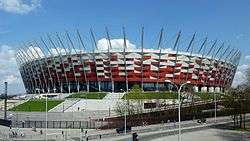
Sports
- Watch football ie soccer. The leading club is Legia Warszawa, who play in Ekstraklasa, the top tier of Polish football. Their home ground is the Piłsudski Stadium (or "Polish Army Stadium"), capacity 31,800. It's at 3 Łazienkowska St., two km southeast of city centre.
- National games are plated at Stadion Narodowy (National Stadium), a multi-purpose arena on the river's right bank, 3 km east of city centre.
- Warsaw Eagles play American football, at the American Football Field, Tobruk Ave, 5 km north of city centre.
Learn
Universities
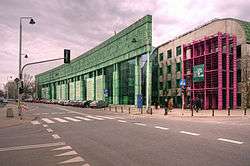
- 🌍 University of Warsaw (Uniwersytet Warszawski), ul. Krakowskie Przedmiescie 26/28, ☎ +48 22 552 00 00. The University of Warsaw is Poland's largest university and offers a large variety of courses and programs to choose from. University of Warsaw has about 50,000 students enrolled.
- 🌍 Warsaw University of Technology (Politechnika Warszawska), pl. Politechniki 1, ☎ +48 22 234 72 11. The biggest Polish technical university.
- 🌍 Warsaw School of Economics (Szkoła Główna Handlowa), al. Niepodległości 162, ☎ +48 22 564 60 00, e-mail: informacja@sgh.waw.pl. Poland's largest economics school.
- Warsaw University of Life Sciences (Szkoła Główna Gospodarstwa Wiejskiego), ul. Nowoursynowska 166. Originally an agricultural school, this is now a rapidly expanding university.
- Collegium Civitas, Plac Kultury i Nauki, 12th floor, pl. Defilad 1, ☎ +48 22 656 71 87. This is a private school located inside the Palace of Culture of Science. Majors include Sociology, Political Science, American Studies, International Relations, and Human Rights and Genocide Studies. For those interested, some programs are conducted in English.
- Warszawski Uniwersytet Medyczny (Medical University of Warsaw). A medical college.
- The Academy of Arts (Akademia Sztuk Pięknych).
- Uniwersytet Kardynała Stefana Wyszyńskiego, ul. Dewajtis 5, ☎ +48 22 561 88 00, e-mail: info@uksw.edu.pl. This is a well-known Catholic university.
- Leon Kozminski Academy, ul. Jagiellońska 59 (Located in the Praga Połnoc district), ☎ +48 22 519 21 00, fax: +48 22 814 11 56, e-mail: uczelnia@kozminski.edu.pl. This is a private school specializing in law and business management majors.
- 🌍 SWPS University.
Polish language
- Institute of Polish Language and Culture for Foreigners, ul. Krakowskie Przedmieście 32, ☎ +48 22 5521530. Part of the Warsaw University. 1200 zł for a standard course or 1800 zł for an intensive one.
- Edu & More Polish Language School for Foreigners, ul. Marszałkowska 87/81, ☎ +48 22 622 14 41. 599 zł for a group course. It's also e-learning platform for learning Polish online.
Work
Home to many international companies, Warsaw has an excellent job market for potential expats. Of course there are several immigration hurdles, but landing a job should not be overly difficult if you have the right skill sets.
If you're a backpacker who is not an EU citizen and looking for short-term employment this may be somewhat more difficult, as you are legally required to have a work permit. You could possibly find short-term work in the hospitality industry, or possibly as a tutor or an ESL teacher.
If you'd like to work in Warsaw, or Poland for that matter, but don't want to go through the hassle of finding a job opportunity, there are some employment recruiting agencies you can use in your search for a job. Just a few are:
- Adecco Poland, Al. Jerozolimskie 123A, ☎ +48 22 529 76 40.
- Randstad, Al. Jerozolimskie 56c, ☎ +48 22 462 25 00.
There is also the possibility to work in startups. Warsaw is the first place for startups in Poland, and the opportunities for foreigners are growing. For some, you do not need to speak the Polish language to start working there. With this website, you can apply directly to recruiting companies, without going through one extra intermediary.
Buy
|
Touts Handing Out Flyers Warsaw has many touts, who mainly congregate at the subway station "Centrum", near the southeastern corner of the Palace of Culture and Science. They pass out fliers and brochures for all kinds of imaginable and useless services. If you don't want to start a collection of fliers, a simple and easy way to beat the touts at their own game is to simply make a gesture indicating stop with your hand while stating in English "No, thank you" or "I can't understand Polish". This works surprisingly well, especially on touts who pass out fliers for English language instruction schools. |
ATMs (Polish: bankomat) are plentiful around Warsaw. Visa, MasterCard, Visa Electron, and Maestro are widely accepted at most establishments. AmEx and Diners' Club are not as commonly accepted. Some establishments require minimum purchases of 10-50zł for credit card purchases.
Indoor shopping malls (Polish: centrum handlowe pl. centra ~, often abbreviated CH) are also plentiful in Warsaw. Usually open until 08:00—22:00, most malls will have a food court, restaurants, cinema, and some may have a sports hall with billiards tables or a bowling alley.
Tesco and Carrefour are the largest stores in Europe, and carry just about everything, including groceries, at low prices.
Eat
Warsaw is not globally renowned for its culinary scene, but it lacks nothing compared to other European capitals with regard to it. There is a wide choice of eateries from the most basic and cheapest to very sophisticated, and many different types of food are available throughout the city. Finding a unique dining experience is feasible daily.
| This page uses the following price ranges for a typical meal for one, including soft drink: | |
| Budget | 30 zł or less |
| Mid-range | 31 zł - 60 zł |
| Splurge | 61 zł and up |
For those on a budget, there are many kebab shops sprinkled around Warsaw, especially in Śródmieście, which offer decent food and portions for the fair price of 7-13 zł a kebab. Other cheap alternatives are milk bars, which are discussed later in the section, and Vietnamese restaurants.
Haute cuisine
If you are looking for a premium dining experience, your best chances are in Śródmieście, but away from the Royal Route. In Praga, head for Saska Kępa, and you will also find a fair share of upscale restaurants in Wilanów. That said, new and innovative places crop up in the most unexpected locations, so do acquaint yourself with the district guides for the latest tips.
Warsaw is home to both Polish restaurants that hold Michelin stars:
- Atelier Amaro, ul. Agrykola 1 (entrance from plac Na Rozdrożu square), ☎ +48 (22) 628 57 47, +48 607 970 000, e-mail: reservations@atelieramaro.pl. Author's cuisine restaurant of chef Wojciech Modest Amaro. The restaurant does not offer à la carte dishes, in fact it doesn't have a fixed menu at all. Smart casual dress code is expected. Menus from 260 zł.
- Senses, ul. Bielańska 12, ☎ +48 (22) 331 96 97, e-mail: restaurant@sensesrestaurant.pl. A "private dining" restaurant, author's cuisine of chef Andrea Camastra. Reservation required. From 170 zł.
Food fairs
The new trend in Warsaw are food fairs, where fresh foodstuffs can be bought directly from producers, both for further processing and preparation at home and as ready dishes for consumption on site. Usually, some space for communal meals is provided. This can be a very nice option for breakfast or lunch. Some of the options are:
- Targ Śniadaniowy (Breakfast fair), al. Wojska Polskiego 1; Skwer Grupy AK Granat and other places. Sa 09:00—16:00. Organised every weekend in various parts of town, usually
Fast food
Tourists will be happy to know there's no shortage of fast food in Warsaw. The city is rife with McDonald's and Subway outlets, there are also many KFCs and Pizza Huts, and a growing number of Burger King restaurants (the latter mostly in shopping centres). For a quick bit, chain cafes that are around every corner in the city centre, the shopping centres and many office buildings will offer you pre-made sandwiches and salads. Some more sophisticated cafes will make salads, ciabattas and sandwiches on site.
There is no particular Polish kind of fast food, as the traditional Polish cuisine does not really lend itself well to quick preparation or quick eating. Therefore, apart from the above international chain places, that niche in Warsaw is filled with kebab places and cheap pizzerias, similar to ones that you would find in most other European cities. Pizzerias are often chain places as well, and many do telephone deliveries, takeaways as well as offer tables to eat on the premises. Kebabs can often only do takeaway, and are often open all night long, much to the delight of taxi drivers and partygoers.
Milk bars
Remnant of the communist era, milk bars (Polish: bar mleczny, bary mleczne) were created in the 1960s to serve cheap meals based on milk products. After the fall of communism, most of them closed down but some survived and still bear the climate from the old days. Almost everything inside looks, feels and smells like in the 1980s. Milk bars attract students and senior citizens, because of the low prices (soup and the main course together may cost as little as 10 zł). The food served by milk bars can actually be quite palatable. Even if you can afford more expensive meals, milk bars are interesting because they offer somewhat a view of life before democratization in Poland. Nowadays they became even that popular, that new chains and milk bars are recreated.
Drink
Old Town and areas like pl. Trzech Krzyży, ul. Nowy Świat, ul. Chmielna, ul. Krakowskie Przedmieście in Śródmieście are saturated with cafés. Coffee typically costs about 10-15 zł. Beer can cost 5-15 zł for half a liter (the supermarket price being 2.50-3 zł). Drink prices in clubs can go up to 50 zł. Drinking alcoholic beverages in public places is prohibited, but there are several places chosen by the local government where it can be possible.
|
Speak easy If you're looking to mingle with real Varsovians, there's a well-kept, secret row of nameless, dark bars located off of Nowy Świat. They are reportedly good for those wishing to participate in the more decadent side of Varsovian night life. In truth, the places attract a younger crowd who want to socialize over a beer (usually a relatively low 6 zł for a half liter). If you'd like to give one of these bars a try, walk through the gateway at Nowy Świat 24. You'll find a few small buildings with bars tucked away. The number one tip about visiting one of these bars is go early if you want find a seat. You won't be able to find one after 22:00. At last count, there are three of the famous "Pijalnia Wódki i Piwa" bars in the city, all of which serve the cheapest beer around. Although these are mostly frequented by locals, Warsaw has a thriving international student community and more often than not, there are some English-speakers around to have a drink with. |
Clubs
Clubs are plentiful in Warsaw and are a very popular way to spend nearly every night out.
The most popular nice and chic clubs are on ul. Mazowiecka in Śródmieście. Note that you will definitely be denied entrance if you wear sport shoes, no matter how expensive they are. Inconspicuous black shoes will normally do the trick.
Student clubs are popular and usually moderately priced, but can be hit or miss. Normally, the centrally located Hybrydy is a good option for night out. Other student clubs, like Stodoła or Remont in Śródmieście, and Park in Mokotów, are less predictable and quality isn't necessarily a concern for these clubs' patrons. If the point is to get drunk, then these are the place to go for a cheap drink.
Beware of certain bouncers (for example in Park), they are not the talkative kind if they suspect you of something.
In addition, there are clubs in Wola and Mokotów as well as several popular and down-to-earth clubs in the Praga districts.
Concerts
Warsaw's music scene can sometimes be disappointing, but it's a matter of knowing where to look because Warsaw has an abundance of musical delights, they just need to be ferretted out. Headline acts perform at the Bemowo airport in the Bemowo district and at the Stadion Narodowy (National Stadium) in the Praga Południe district of Warsaw. Smaller acts are hosted at clubs and concert halls around the city, but primarily in the center of Warsaw.
Tea and coffee
Throw stereotypes out the door. For Poles, one of the most important staples to quench their thirst is not wódka or beer, but rather tea and coffee. As such, you're likely come across dozens and dozens of cafés. Chain-wise, Coffee Heaven and W Biegu Cafe are the big players. Starbucks is also in Warsaw. The real treat of Warsaw, however, are small cafés that are littered about Warsaw. For the most part, a good cup of tea or coffee can be had for 5-10 zł a cup. A small tea kettle is between 20-30 zł.
Sleep
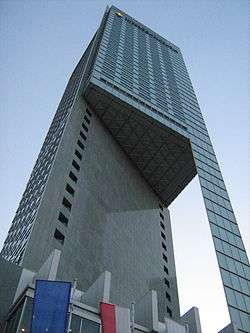
There are plenty of accommodation options in Warsaw at all budget levels. The most accommodation options are located in Śródmieście, Wola, and Mokotów. There are also many business travel hotels in Włochy, near the airport.
Warsaw has an oversupply of high-standard hotel rooms, as many luxury hotels were built in Warsaw after 1989. Almost every global upscale chain has at least one property, a few hundred rooms each. Therefore, you can easily snatch room at a modern four- or five-star hotel in the €50-70 range. Warsaw still sees more business than leisure travel, so your best bet to get a great rate are weekend stays. Look for offers and special rates in booking sites and hotel web pages.
If you are on a budget, do not assume that hostels are your only option. Booking in advance at 3/4 star hotels can yield prices only slightly higher than backpacker hostels, for far greater comfort. Do your research in any case before booking to make sure you do not miss out on a great offer.
Breakfast is not included in the room price in most hotels in Poland. Expect steep charges for breakfast, especially if you book a premium hotel at a low price. If you are staying in the city centre, you might find many other breakfast options around your hotel though.
There are campgrounds in Włochy, Wawer, Wola, Ochota and Mokotów.
Connect
Postal service
- Central Post Office (Poczta Główna), ul. Świętokrzyska 31/33. Open 24/7.
Internet
Wifi
Free wi-fi is very widespread in Warsaw. Municipal hot-spots (freewifi.waw.pl) are free of charge and available in over 150 localities throughout the city. Those include the Old Town, most of public parks, major city squares, the vicinity of most public buildings and museums. They are all marked by blue or purple "HOT SPOT UM-Warszawa" plaques hanging on street lamps. It is also available in over 300 city buses and some tramways (marked with a white and blue wi-fi icon at the doors).
Most restaurants and cafes also offer access to free wi-fi. The networks are usually either open, or require a password (usually available at the bar) or accepting the regulations (usually in Polish).
Computers and Internet cafés
Internet cafés (Polish: kawiarenka internetowa) are rare in Warsaw.
- Tourist Information Center (Palace of Culture and Science Building, just opposite the Central Train Station). You can use the computers with Internet for 30 minutes for free.
- Arena, Booth 2001D, Centrum metro station building (500m north from Central Train Station at ul. Marszałkowska, across hotel Novotel), ☎ +48 22 620 80 32. 07:00-00:00. Over 20 machines. 5 zł/hour, pay as you go.
- Cafe NET, Booth 2010C, Centrum metro station building (500m north from Central Train Station at ul. Marszałkowska, across hotel Novotel). 07:00-00:00. Over 20 machines. 6 zł/hour, prepay.
- Verso, Freta 17 (Stare Miasto – Old Town). Photo and printing shop in which there are 3 computers for public Internet access. 5 zł/hour; 1 zł/5 minutes.
Telephones
The area code for Warsaw is 22, and it must be dialed even when making local calls. When calling internationally to Warsaw, dial the country code, +48, followed by the rest of the number. There is no necessity to use "0" at the beginning of the telephone number. When dialing from a mobile phone, you must dial any number as if it was an international number.
Pay phones are very rare and it is therefore best to rely on other means of communication. Pay phones are only operable using calling cards that can be bought at post offices.
Pre-paid SIM cards with Polish phone numbers cost as little as 5 zł and can be purchased from just about any major carrier. Many kiosks sell them.
Stay safe
Surprisingly enough, Warsaw is a very safe city overall. The city center has a strong police presence and is generally a very safe area. The Praga districts used to be dangerous, but this is generally more hype than reality. Of course, it would be wise to exercise a little extra caution if you're in an area you do not know well. The bus and rail stations can be a magnet for homeless and drunkards, who, for the most part, will leave you alone.
Some areas south of the Palace of Culture and Science and the train station have a rather seedy feel to them, expecially at night. Same goes for much of the neighborhoods immediately surrounding Warsaw-Chopin airport.
Though nowhere nearly as prevalent as in other major cities, pickpockets can sometimes be a problem and you should be careful to hold onto your belongings when in a large crowd or on buses (Number 175, which runs from the airport to city center, is reportedly infamous for pickpockets). At bars and clubs, a good rule of thumb is the cheaper the door entry and the laxer the bouncers are about letting people in, the more likely you're going to want to keep extra care of your wallet, passport, cell phone, and camera.
Violent behavior is extremely rare and if it occurs it is most likely alcohol-related. While pubs and clubs are generally very safe, nearby streets may be scenes of brawls, especially late at night. Try to avoid confrontations. Women and girls are generally less likely to be confronted or harassed since the Polish code of conduct strictly prohibits any type of violence (physical or verbal) against women.
Visitors not knowing Polish may also be the target of "bar girls," especially in Underground off of ul. Mazowiecka on days where there isn't a cover charge. Be cautious if you encounter a girl speaking English who will offer you a drink or a cigarette. She will then ask you to walk her to her car parked outside of the club and then explain how her friend still inside of the club has her car keys. Then she will ask if you would like to share a cab back to her place for 70 zł and then go back to the club. Doing so puts yourself in danger because it isn't known where she lives and you could be setting yourself up for possible harm or other scams.
Just like in any other major European city, football hooligans can be a problem before or after large football events. Naturally, it's best to avoid them, because they might be violent. At the same time, all major sport events are monitored and controlled by special police units, so unless you find yourself in the middle of the confrontation between hooligans and the police, you should be fine.
In case of emergencies, call emergency services. The number for the police: 997, firefighters: 998, Ambulance: 999. The common European emergency number 112 works too.
Cope
Religious services
- St Paul's English Speaking Catholic Parish of Warsaw (Kaplica Niepokalanego Poczęcia Najświętszej Maryi Panny), ul. Radna Street 14, ☎ +48 22 826 73 95. The Holy Mass in English on Sunday at 11:30.
- International Christian Fellowship, ul. Puławska 326 (Corner of ul. Puławska and ul. Płaskowickiej. In the Ursynów district), ☎ +48 607 309 490, fax: +48 22 844 7996, e-mail: contact@icf-pl.org. Service is held every Sunday at 10:30. This is a non-denominational church with Protestant leanings. Anyone and everyone is welcome and if you're a newcomer you're likely to be greeted by people who notice a new face in the crowd. You may even be invited for coffee after the service. The congregation is made of Brits, Germans, Poles, Americans, and Aussies, and other nationalities.
- 🌍 Nożyk Synagogue (Synagoga Nożyków), ul. Twarda 6, ☎ +48 22 652 28 05, fax: +48 22 652 28 05, e-mail: varshe@jewish.org.pl. Erev Shabbat services begin 15 minutes before sunset. Shabbat morning services begin at 9:30AM. This is Warsaw's only Orthodox Jewish synagogue that is still in operation.
- Warsaw International Church, ul. Miodowa 21b (Metro: Ratusz), ☎ +48 22 842 23 51, e-mail: pastor@wic.org.pl. Worship service and Sunday School every Sunday at 11:00.
- Islamic Center of Warsaw, ul. Wiertnicza 103, ☎ +48 22 88 56 276.
- Sikh Temple Warsaw, ul. Na Skraju 56, Raszyn, ☎ +48 22 86 84 541.
Laundry
Most hotels and hostels either offer laundry services or have washers and dryers available for use by guests. Additional fees may be incurred for use of these services or machines. Otherwise, you can find a full-service laundry shop at just about any mall, however, these might be expensive. There are self-service laundromats in Warsaw:
- Blanc Lys Laundry, ul. Księcia Janusza 23, ☎ +48 508 162 810. 08:00-20:00.
Embassies





















Go next
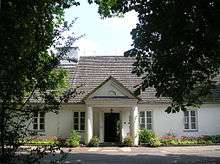
- Kampinos Forest (~15 km, take the 708 bus from Młociny underground station) – A wild and beautiful primeval forest, often called the green lungs of Warsaw, and an ideal choice for a day off from the noise of the city
- Konstancin-Jeziorna (~20 km, take the 700 bus) – A spa town with a spacious park. Famous for its clean air and high housing prices.
- Kraków (~300 km, in just under 3 hours by hourly IC/Ex trains) – The former capital of Poland, this was the European City of Culture in 2000.
- Lublin (~200 km) – A medieval city with a well preserved old town, it is now the largest city and main tourist attraction in eastern Poland.
- Kazimierz Dolny (~150 km, less than two hours by TLK train to Puławy, then half an hour by bus) – A Renaissance town with a picturesque marketplace, it is a hub for painters and Boheme.
- Żelazowa Wola (~50 km) – The birthplace of Frédéric Chopin.
- Brest, 200 km away in Belarus, on the border with Poland and rich with history from both the Soviet times and before. The Brest Hero Fortress is perhaps the most impressive Soviet monument ever built, and there's the train museum, and its incredible collection of Soviet-time locomotives,as well. You can go there by train (one train a day, that 4-5 hrs). Same visa regulations as rest of Belarus; the new visa-free regulations for citizens of 80 countries since 2017 is not eligible when coming/leaving by train.